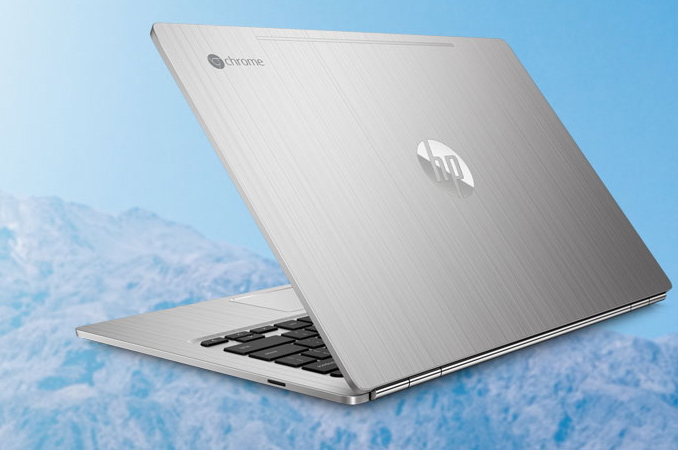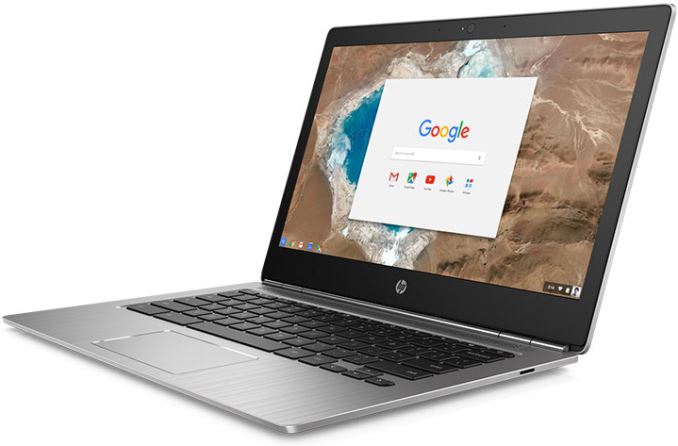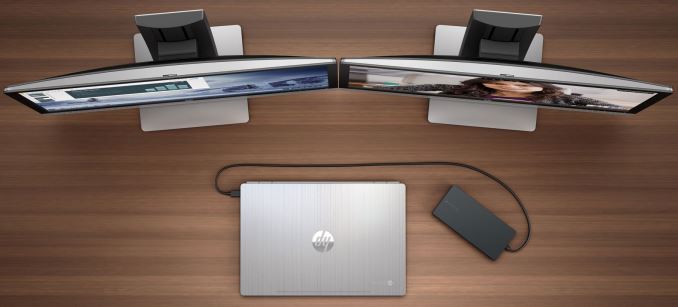HP Unveils Premium Chromebook: 3K Display, Intel Core M, 16 GB of RAM and USB-C
by Anton Shilov on May 3, 2016 8:00 AM EST
HP has announced a new family of Chromebooks, which are powered by Intel’s high-performance processors and feature stylish design, aluminum body, high-resolution display and even Bang & Olufsen speakers. The new laptops will not be as affordable as many other mobile PCs running Google Chrome OS and will not be as powerful as Google’s Pixel, however, this is what HP believes to be the right balance between performance, style, portability and price.
When Acer and Samsung introduced their first notebooks based on Google’s Chrome OS in mid-2011, they praised their low price and mainstream computing capabilities. At the time, Chrome OS was a mystery for most people, netbooks were relatively popular and it made sense for the aforementioned PC makers and Google to address the entry-level segment of the market with something very affordable. As Chrome OS gained traction, PC makers began to install higher-performing components into their Chromebooks. However, they were still not ready to address the high-end market segment with such PCs, which is why Google released its Pixel laptop in 2013. The Chromebook Pixel is one the most advanced and stylish Chromebooks ever made because of its Core i7 “Broadwell” CPU, a display with 2560×1700 resolution and 3:2 aspect ratio. But, the Pixel costs $999 and not all users are ready to invest that sum in a Chromebook. Fortunately, different PC makers offer various systems that attempt to replicate some of the Pixel’s features. HP decided to build its own competitor for Google’s Pixel and while the product is not exactly affordable, it has a better screen than most Chromebooks and a number of other advanced features.
The HP Chromebook 13 sports a 13.3” IPS display with 3200×1800 resolution (QHD+), 170-degree viewing angles and 16:9 aspect ratio, which is good for multimedia applications and video. HP’s latest Chromebook comes in brushed anodized aluminum chassis, it is 12.9 mm thick and weighs 1.29 kilograms (2.86 pounds), which is thinner and lighter than Apple’s MacBook Air 13”. Despite the very high resolution screen, the laptop works up to 11.5 hours on one charge of its 45 Wh battery, according to the manufacturer.
To enable long battery life, HP used Intel’s Skylake-Y system-on-chips to build its Chromebook 13. Various versions of the system are powered by either Pentium or Core M SoCs with two cores, Intel’s HD Graphics 515 (Gen9) core with 24 EUs (execution units) as well as 6W or 4.5W TDP. The system will likely be considerably faster than other Chromebooks running Atom, Celeron or Pentium processors because of the high-performance CPU architecture.
| HP Chromebook 13 Specifications | |||||
| Screen Resolution | 3200×1800 | ||||
| CPU | Intel Core m7-6Y75 | Intel Core m5-6Y57 | Intel Core m3-6Y30 | Intel Pentium 4405Y | |
| Graphics | Intel HD Graphics 515 (Gen9, 24 execution units) | ||||
| RAM | 16 GB | 8 GB | 4 GB | ||
| Storage | NAND flash storage | ||||
| Wi-Fi | 2x2 MIMO 802.11ac Wi-Fi module (?) | ||||
| Bluetooth | Bluetooth 4.2 (?) | ||||
| USB | 2×USB-C, 1×USB-A ports | ||||
| Other I/O | Microphone, stereo speakers, audio jack | ||||
| Thickness | 12.9 mm/0.5 inch | ||||
| Weight | 1.29 kilograms / 2.86 pounds | ||||
| Price | $1029 | $819 | $599 | $499 | |
Depending on the model and price, the HP Chromebook 13 can be equipped with 4, 8 or 16 GB of RAM, an unknown amount of solid-state storage as well as wireless connectivity technologies (a 802.11ac Wi-Fi module with Bluetooth 4.2 is likely, but is not confirmed by HP). HP notes that its system has a full-sized backlit keyboard as well as Band & Olufsen-tuned speakers, which is something new for a Chromebook. The system also has a webcam, three microphones, a 3.5 mm audio port, a SD card reader, one USB Type-A port as well as two USB Type-C ports. The Chromebook 13 uses USB-C for charging and is therefore compatible with a variety of third-party chargers.
With its advanced Chromebook 13, HP offers its Elite USB-C Docking Station ($149), which plugs in to a USB-C port on the PC and enables to connect up two Full HD displays, Gigabit Ethernet as well as multiple USB Type-A devices, such as keyboards or mice.
Four versions of the HP Chromebook 13 should hit the U.S. retail shortly. The most basic model running the Intel Pentium 4405Y processor and equipped with 4 GB of RAM will cost $499, whereas the top-of-the-range system featuring the Intel Core m7-6Y75 and 16 GB of RAM will cost $1029, which is even more than Google’s Pixel.
















145 Comments
View All Comments
annomander - Thursday, May 5, 2016 - link
That doesn't make senseSaolDan - Tuesday, May 3, 2016 - link
Where u get a sp4 16GB 256GB i5 for that price? Was it hot?BrokenCrayons - Tuesday, May 3, 2016 - link
The Surface Pro 4 is a tablet computer which is in a different market segment. It also costs a bit more if you want to have similar functionality because you'd need to purchase a keyboard whereas HP's Chromebook includes a keyboard by default due to its laptop style design. But really, I think we're splitting hairs here. $1200 or $1000...the difference is pretty meaningless as is the purchase price. We're talking about the equivalent of a day or two's living expenses and shopping for the average person, not buying a decent home. Maybe if we were to multiply the price of either of these two by 50 or so it'd be reasonable to bat an eyelid or think twice about which is a better purchase.quielo - Tuesday, May 3, 2016 - link
"Chromebooks are a rarity in the wild" Go to a school sometime. Chromebooks are ideal as a shared device in the educational setting and they are beating apple like a drum.nikon133 - Monday, May 9, 2016 - link
Until those poor kids finis school, find job... and end up staring at Windows machine with MS Office installed on it. Maybe some MS Visio and Project on top.Really... I can see attractiveness that Chromebooks hold for school managements... but that's short term. I don't think that they are preparing kids for real life in the best possible way. Maybe in the most convenient way (for schools), but not for kids.
Grubel - Tuesday, May 3, 2016 - link
Any Linux OS can be installed in any Chromebook.okay - Tuesday, May 3, 2016 - link
No, actually, Chrome OS is the single best operating system to get if you want you to install other operating systems simultaneously. Chrome OS lets you install another version of Linux base system like ubuntu which runs simultaneously and natively, not in a VM. Not dual boot. There's simply nothing else like this elsewhere. From there it's a simple matter to run virtualbox if you really want a non linux-based OS. Being able to switch between Ubuntu and Chrome OS is everything I need and it's absolutely wonderful!BrokenCrayons - Tuesday, May 3, 2016 - link
Conventional PC hardware can dual or triple boot multiple operating systems without the drudgery of a VM. Chrome OS does allow the installation of a Linux distro, but it's certainly not the only OS/hardware combination that can switch operating systems easily.okay - Tuesday, May 3, 2016 - link
It looks like you may have commented without reading my comment. ChromeOS is the best OS to get if you want to *install* simultaneously, but it is the ONLY consumer OS to get if you want to *run* another linux-based OS simultaneously. Without a dual boot, and without virtualization! No performance penalty! Google "Chroot" if you want more info. Neither Windows (as released) nor MacOS allow you to *run* an entirely different OS *simultaneously*.Microsoft is trying to copy the versatility of chromebooks with a linux compatibility layer - we'll see how that works out.
lmcd - Wednesday, May 4, 2016 - link
This is the most hilarious take on ChromeOS I've ever heard. Quite frankly, if this is your take then Windows and OS X both have ChromeOS built in. ChromeOS is not an OS, it's a DE with a web browser and no installation privileges. Stop citing Linux desktop like it's a feature or a different OS.